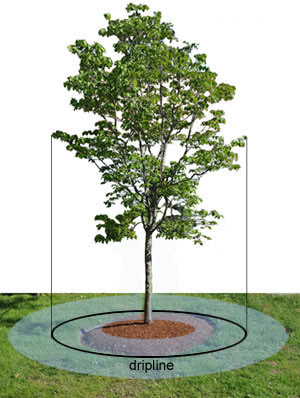In the enchanting realm of nature, where forests whisper and trees dance to the wind’s delicate melody, lies an intriguing secret beneath every towering trunk. Timeless and mystical, the drip line of a tree unveils nature’s meticulous craftsmanship. Serene and enigmatic, this unseen path whispers stories of a tree’s triumphs and resilience. Join us as we embark on a journey to uncover the veil of foliage, unveiling the enigmatic allure of the drip line, and delving into the hidden wonders that lie beneath the shadows of these arboreal giants. Dust off your curiosity and venture forth, for the secrets of the drip line await, eager to be unraveled amidst nature’s eternal embrace. Welcome to the wondrous world of the drip line; where the roots kiss the sky and whispers of the earth tickle our imagination.
Understanding the Drip Line of a Tree: An Essential Element of Tree Care
The drip line of a tree holds a hidden significance in the world of tree care, yet many may overlook its importance. As we delve into the depths of this essential element, we unlock the secrets of how it affects a tree’s well-being, growth, and overall health.
Picturing a tree’s drip line is akin to envisioning an invisible umbrella that stretches outwards from the tree’s branches. It marks the outermost point of a tree’s canopy, where raindrops gracefully cascade down, falling leaf by leaf. This region encapsulates an intricate network of interconnected roots that tirelessly absorb all the nutrients, water, and minerals required for the tree’s survival.
Exploring the Features and Tips for Managing the Drip Line:
| Feature | Tip |
|---|---|
| Mulching: | Applying a layer of organic mulch, such as wood chips or compost, around the drip line helps retain moisture, suppresses weed growth, and regulates soil temperature. |
| Proper watering: | Consistently watering the area within the drip line, rather than at the base of the trunk, ensures that the tree’s roots receive sufficient hydration, promoting healthy growth. |
| Protected construction zone: | Avoiding any construction activities within the drip line helps prevent damage to the delicate roots, maintaining the tree’s stability and vitality. |

Unveiling the Importance of the Drip Line for Tree Health and Growth
The drip line of a tree may seem like a simple concept at first glance, but its importance for the health and growth of a tree cannot be overstated. Imagine that you are standing under a tree during a gentle rain shower. As the raindrops fall, they hit the leaves and branches, eventually making their way down to the ground. The path that these raindrops take is called the drip line.
The drip line is essentially the outermost perimeter of a tree’s canopy, marking the area where water drips off the leaves and branches and onto the soil below. It is crucial to understand the significance of the drip line when it comes to tree care and maintenance. Properly watering a tree and providing it with essential nutrients can greatly impact its overall health and growth. By focusing on the drip line, you can ensure that your tree receives the necessary water and nutrients it needs to thrive. Here are some features and tips to consider when dealing with the drip line:
| Features/Tips | Description |
|---|---|
| Watering | The drip line is the ideal area to water your tree as it mimics the natural rainfall distribution. Watering close to the trunk can lead to shallow root growth and promote disease. |
| Root Zone | The majority of a tree’s roots are concentrated in the area beneath the drip line. Providing water and nutrients in this zone ensures that the roots can adequately absorb and distribute them throughout the tree. |
| Mulching | Applying a layer of mulch around the drip line helps retain moisture, regulates soil temperature, and suppresses weed growth. Avoid piling mulch directly against the trunk to prevent rot. |
Understanding and recognizing the importance of the drip line for tree health and growth is a key aspect of effective tree management. By adhering to proper watering techniques, focusing on the root zone, and utilizing mulching strategies, you can promote the overall well-being of your tree. So, remember, the next time you find yourself standing under a tree in a gentle rain shower, take a moment to appreciate the drip line and the vital role it plays in keeping our arboreal friends strong and healthy.
Nurturing Trees: Best Practices for Maintaining and Caring for the Drip Line
The drip line of a tree, also known as the canopy drip zone, refers to the outermost edge of a tree’s branches, where rainwater naturally falls and drips to the ground. This area is vital for the tree’s overall health and vitality, as it is where the majority of the tree’s feeder roots are located. Understanding the importance of maintaining and caring for the drip line is essential for nurturing healthy and thriving trees.
To ensure optimal growth and longevity, here are some best practices for maintaining and caring for the drip line:
-
Mulching: Apply a layer of organic mulch, such as wood chips or shredded bark, around the drip line of the tree. This helps retain moisture, regulate soil temperature, and suppress weed growth. Be sure to leave a gap between the mulch and the trunk of the tree to prevent decay and pest issues.
-
Watering: Provide regular watering to the drip line area, especially during dry spells or periods of drought. Slow, deep watering is ideal to allow the moisture to penetrate the soil and reach the feeder roots. Consider using a drip irrigation system or a soaker hose for efficient and targeted watering.
In order to properly care for the drip line, it is important to understand the unique features and tips that come with it. Here is a table highlighting some key features and tips for maintaining and caring for the drip line of trees:
| Features | Tips |
|---|---|
| 1. Canopy cover | Trim back any branches or foliage that extends beyond the drip line to prevent excessive shading and competition for resources. |
| 2. Feeder roots | Avoid compacting or disturbing the soil in the drip line area, as it can damage the delicate feeder roots. Use caution when performing any construction or landscaping activities near the tree. |
| 3. Nutrient absorption | Regularly apply organic fertilizers or compost around the drip line to provide essential nutrients for the tree’s growth and development. |
By implementing these best practices and investing time in nurturing the drip line, you can ensure the overall health and well-being of your trees. Remember, a well-cared-for drip line translates into happy and thriving trees that not only beautify your surroundings but also contribute to a healthier environment.
Maximizing the Benefits of the Drip Line: Expert Tips for Effective Tree Care
The drip line of a tree refers to the outermost perimeter beneath the canopy where rainwater naturally drips down onto the ground. It is crucial to understand this concept, as maximizing the benefits of the drip line is paramount for effective tree care. By focusing on this area, you can ensure your trees receive the necessary nutrients, water, and protection for healthy growth and longevity.
To make the most of the drip line, follow these expert tips:
- Mulching: Apply a two to three-inch layer of mulch around the drip line of the tree. This helps retain moisture, suppresses weed growth, and regulates soil temperature for optimal root health.
- Watering: Slowly water within the drip line, targeting the root zone. This ensures deep root penetration while minimizing runoff. Avoid watering directly against the trunk, as it may cause rot or disease.
- Pruning: Regularly trim branches that extend beyond the drip line. This allows more sunlight to reach the tree’s foliage and helps maintain a strong, balanced structure. Ensure proper pruning techniques to avoid damaging the tree.
In addition, implementing these features and tips will further enhance your tree care efforts:
| Feature/Tips | Description |
|---|---|
| Fertilization | Apply a balanced, slow-release fertilizer around the drip line to provide essential nutrients. |
| Pest and Disease Control | Regularly inspect the tree and surrounding areas for signs of pests or diseases. Take appropriate measures to prevent or treat any issues. |
| Protection from Foot Traffic | Install fencing or barriers to prevent compaction and damage from human or animal traffic near the tree. |
By incorporating these strategies into your tree care routine, you can maximize the benefits offered by the drip line. Remember, healthy trees not only beautify our surroundings but also contribute to a sustainable and nurturing environment for all. So take care of your trees and let their beauty thrive!
Frequently Asked Questions
Q: What is the drip line of a tree?
A: Ah, the graceful dance of nature’s shower, let me enlighten you. The drip line of a tree, my curious friend, is the imaginary perimeter that encapsulates the shadowy reach of its luscious canopy. It’s the outer edge where dreams of sunshine mingle with droplets of rain, where leaves whisper secrets to the wind and roots embrace the earth.
Q: How is the drip line of a tree significant?
A: Ah, the significance lies in the delicate communion between tree and earth. You see, within this mystical boundary, the drip line serves as the arboreal maestro, orchestrating nature’s symphony. As raindrops gracefully ripple down its branches, the drip line ensures every precious droplet falls within its ethereal boundary, nourishing the thirsty soil below. It acts as the guardian of life, feeding not just the tree, but also fostering a vibrant ecosystem where critters and plants rejoice in the cycle of existence.
Q: Why should we pay attention to the drip line?
A: Ah, dear seeker of knowledge, paying heed to the drip line allows us to honor the wisdom of the tree. By recognizing this boundless circle of sustenance, we can ensure the tree’s prosperity and longevity. Stray too close, fellow wanderer, and tread upon its roots, and you risk tainting the delicate balance nature has so skillfully woven. Thus, the drip line acts as our silent guide, reminding us to appreciate the miracles of nature, teaching us to marvel at the complexities of life, and urging us to protect the sanctity of this fragile web we call our home. And there you have it – an exploration into the wonder hidden beneath a tree’s lush canopy. The drip line, a name so unassuming yet holding such significance within the realm of nature’s artistry, is a testament to the interconnectedness of all living things.
As we peel back the layers of this hidden gem, we begin to understand that the drip line is more than just a mere circle on the ground. It is the dance floor for nature’s symphony, where each raindrop takes center stage, embodying life-giving melodies that nourish and sustain the tree’s every fiber.
Imagine, if you will, a masterpiece in motion. Picture the graceful branches swaying in the gentle breeze, casting their protective shadow onto a stage blanketed with fallen leaves. Here, nourishment becomes an intricate choreography, as the tree’s roots extend their delicate tendrils, caressing the earth in search of sustenance.
Like a graceful ballerina, the drip line commands attention as water droplets twirl from above, landing gently upon the orchestral floor. Each drop carries with it the essence of life, quenching the tree’s thirst and feeding its ever-hungry spirit. It is within this artistic interplay that the symbiotic relationship between tree and soil blossoms, reminding us of the delicate balance that sustains our planet.
As we bid adieu to the mysteries of the drip line, let us not forget the profound connection it creates between tree and earth, weaving together a beautiful tapestry of life. So, the next time you stand beneath the sheltering branches of a mighty oak or find refuge beneath the vibrant canopy of a weeping willow, pause for a moment and marvel at the intricate rhythms that unfold beneath your feet.
For within the drip line’s embrace, you shall discover the symphony of life’s dance, where nature’s beauty and harmony intertwine, reminding us of the wonders that lie just beneath the surface of our earthly existence.
- When to Put Weed and Feed on Lawn in Michigan - October 16, 2023
- When to Fertilize Potatoes Plants - October 16, 2023
- Can You Plant Clover in the Spring - October 16, 2023
Contents
- 1 Understanding the Drip Line of a Tree: An Essential Element of Tree Care
- 2 Exploring the Features and Tips for Managing the Drip Line:
- 3 Unveiling the Importance of the Drip Line for Tree Health and Growth
- 4 Nurturing Trees: Best Practices for Maintaining and Caring for the Drip Line
- 5 Maximizing the Benefits of the Drip Line: Expert Tips for Effective Tree Care
- 6 Frequently Asked Questions

